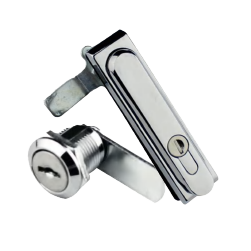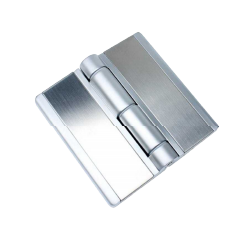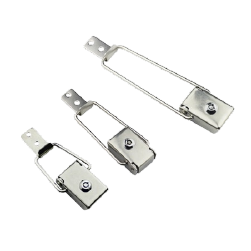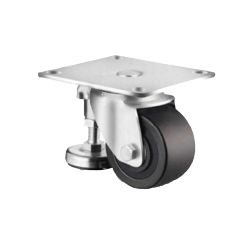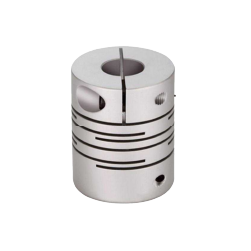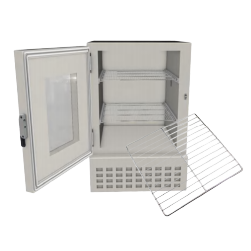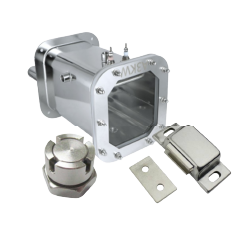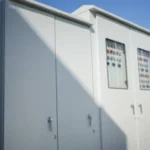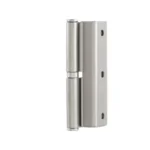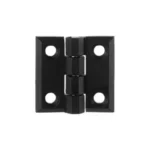Introduction

The hinge is one of the most basic and yet most neglected components in the wide world of hardware. It is the quiet, unwavering pivot around which our day-to-day worlds turn. Whether it is the residential doors or the precision enclosures that contain the critical servers and industrial machinery, the hinge allows movement and provides extra support. The butt hinge is the archetype of hinges, and as the most common type of hinge, its many forms, simple, strong, and durable, it has been used by architects and engineers over the centuries.
This tutorial is devoted to the in-depth investigation of this vital device. We will cut it open, classify its different types of hinges, especially industrial ones, and give it a strict structure of how it should be selected and used.
What is a Butt Hinge?
A butt hinge is a hinge made of two rectangular metal plates, or leaves, which are connected by a hinge pin and barrel mechanism, the knuckle. It is characterized by its method of installation: when installed, the two leaves are mortised into the butt of the door and the matching frame, and can be flush with the surfaces, creating a clean flush finish on the surface of the door. When the door is shut, the knuckle of the hinge is the only visible part of the hinge, giving a clean and unobtrusive appearance. This simple, sturdy construction has led to the butt hinge being the most popular and most used hinge on doors, gates, enclosures and cabinets in the industrial, residential and commercial environments. Its simplicity is deceptive in that it has great potential for strength and durability and is the foundation of safe and functional access points.
How Do Butt Hinges Work?
The working principle of a butt hinge is a masterclass in mechanical simplicity. It allows movement along one axis of rotation. The two hinge leaves are fastened to different objects, one to the fixed door frame and the other to the moving part, door or panel. The knuckle is a set of hollow, interlocking cylindrical parts that connect the leaves. These aligned knuckles are pinned together with a metal pin through the center, forming a strong, single pivot point.
When pressure is exerted on the door, the leaves turn around this central pin. The main resistance to this movement is the friction between the pin and the inner surfaces of the knuckle. The beauty of the design is that it directly translates force into a smooth, arcing movement, so that a heavy, awkward object such as a door can be moved with little effort. The whole weight, whether at rest or in motion, is carried by the leaves and supported by the pin and knuckle assembly.
Anatomy of a Butt Hinge
In order to comprehend its role and choose the right model, it is necessary to know the peculiarities of the parts that make up a butt hinge.
- Leaf: This is the rectangular, flat plate of the hinge which is attached to the door and the frame. There are two leaves in each butt hinge. They have screw holes, usually countersunk so that the screw heads are flush with the surface of the leaf, so that they do not interfere with the operation of the door. The overall strength of the hinge is determined by the thickness, size, and leaf height of the leaf.
- Knuckle: The knuckle is the hollow, cylindrical part of the hinge through which the pin goes. The leaves are connected by a row of knuckles that fit into the knuckles of the opposite leaf, like the fingers of two hands clasped together. The knuckle length and diameter also play a major role in the load bearing capacity and durability of the hinge. The knuckles may be more or less, and the more knuckles the more stability.
- Pin: The pin is the solid rod that slides into the aligned knuckles and holds the two leaves together and acts as the axis of rotation. The pin may be fixed, that is, it cannot be taken out, or loose, so that the door can be easily separated from its frame without unscrewing the leaves. The shear strength is dependent on the material and diameter of the pin, especially on heavy doors.
Types of Butt Hinges
While the basic design is universal, traditional hinges like butt hinges have evolved into numerous specialized types to meet the distinct demands of different applications. Understanding these variations is the first step toward making an informed selection.
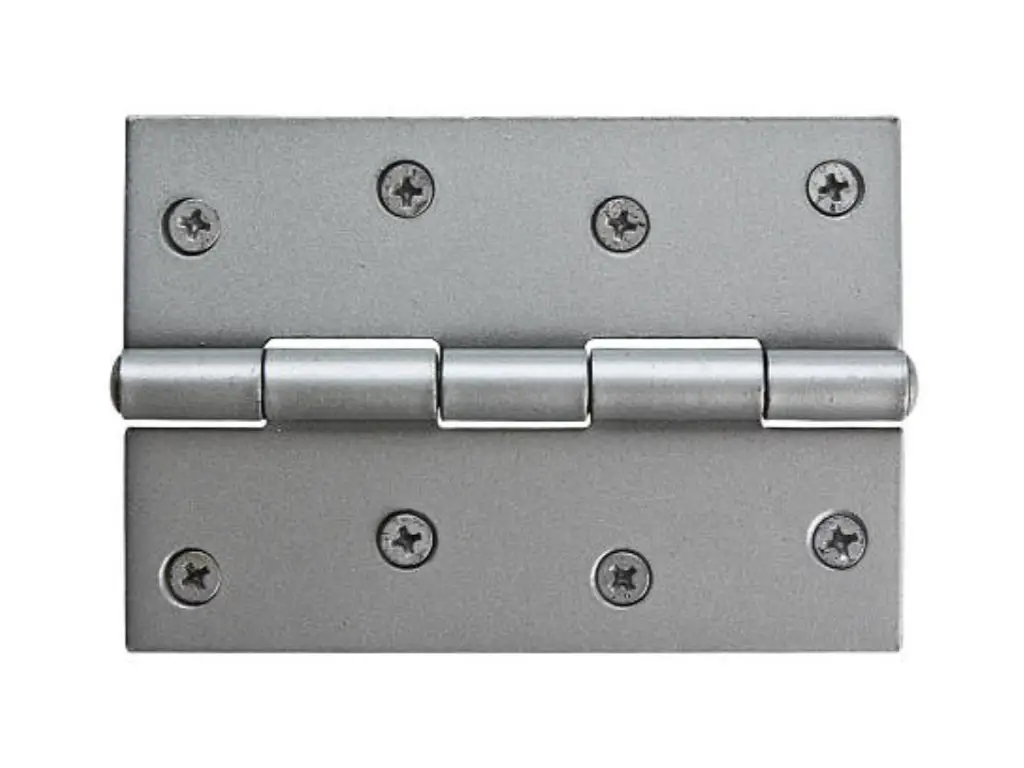
Plain Bearing Butt Hinge
This is the simplest and most common type of butt hinge. The knuckles of the leaves in a plain bearing hinge are in direct contact and rotate against one another. They are a cheap and dependable way to do lightweight doors, and their most common use is on low-traffic lightweight interior doors; in an industrial setting, you may see them on internal, non-critical access panels. They are not suitable on heavy, high-use, or exterior doors because the direct metal-on-metal friction makes them less durable, which will wear out faster and will tend to squeak with age.
Ball Bearing Butt Hinge
The ball bearing butt hinge is a considerable improvement over the plain bearing model, with small hardened steel ball bearings between the knuckles. These bearings provide a cushion, which minimizes friction significantly. This makes it a lot smoother, quieter, and longer lasting, especially for applications with frequent use. They are the typical suggestion on heavy entryway doors, high traffic commercial entryways, and any large door that is solid metal. Their long life and ease of swing make them worth the extra expense in heavy-duty uses. This reliability also makes them necessary in commonly used industrial doors, like on server racks and communication cabinets, where long-term, dependable cycling is critical.
Spring Butt Hinge
This kind is also referred to as a self-closing hinge and it has a spring mechanism in the knuckle barrel. This spring causes tension when the door is opened and then utilizes that stored energy to automatically pull the door closed. Building codes often require fire doors to be equipped with them so that they stay closed, and they are also frequently applied to cabinet doors or screen doors. The same self-closing principle is used to provide safety on some industrial machine guards, so that panels cannot be left open by accident. The tension is usually adjustable and the closing speed and force can be controlled.
Rising Butt Hinge
This is a brilliant design that is designed to raise the door a little when it is opened. The two parts of the knuckle are helical or ramped on the side where they come together. The leaf on the door rides up this ramp as the door swings open, lifting the whole door a little bit, usually about a half inch. This comes in handy when clearing thick carpets or uneven flooring so that the bottom of the door does not drag. When the door is released, gravity assists it to close as it slides back down the ramp.
Offset Hinge
An offset hinge is made to swing a door fully out of the doorway. Its leaves are J-shaped and shift the pivot point off the door jamb. This makes a broader, clearer opening, frequently a necessity to be ADA (Americans with Disabilities Act) compliant in commercial buildings to accommodate wheelchair access. The same maximization of clearance principle is also useful in industrial cabinets, where the internal racks or components can be removed completely without removing the door from the hinges.
Heavy-Duty Butt Hinge
They are, in effect, massively over-engineered standard butt hinges. They are made of thicker gauge steel or stainless steel, have larger and stronger knuckles and a larger diameter pin. They are specifically made to fit very heavy or oversized gates, industrial doors, large power distribution cabinets, vault doors, and large container lids. They are frequently equipped with ball bearings or oil-impregnated bronze bushings to cope with the huge friction caused by heavy loads.
Weld-On Hinge
The weld-on hinge is the answer to applications where ultimate strength and a permanent bond are needed. These hinges are flat, plain, and are meant to be welded directly to a steel door and a steel frame instead of having screw holes in the leaves. This forms an extremely strong, unbreakable bond that is perfect in heavy security gates, steel safes and enclosures of heavy machinery where vibration and high stress destroy a bolted connection.
Stainless Steel Hinges
Although stainless steel is a material, it also characterizes an important type of hinges in special environments. Grade 304 or, in case of better protection, Grade 316 hinge material stainless steel hinges are selected due to their outstanding corrosion resistance. They are necessary where they are used in marine applications, outdoor EV charging cabinets, chemical processing plants, environmental test chambers, and other installations where a standard steel hinge would be rapidly ruined by exposure to moisture, salt, or harsh chemicals. The use of stainless steel is critical in these scenarios.
A Step-by-Step Guide to Choosing the Right Butt Hinge
Selecting the correct hinge is not a matter of guesswork; it is a methodical process of matching a product’s specifications to the demands of the application.
Step 1: Identify Application & Key Performance Requirements
The first step before you think about any hardware is to define the project. Is it an interior residential door, a commercial storefront entrance, or the access panel on an industrial machine? The main requirements are determined by the answer. In the case of a home, it may be aesthetics and silent operation. In the case of a commercial door, durability and ADA compliance are essential. In the case of an industrial cabinet in a corrosive environment, the most important thing is the integrity of the material and the sealing ability. Determine high-level objectives such as security, an IP rating required to seal, budget, and desired life at the beginning.
Step 2: Determine Load Capacity & Frequency
This is a critical engineering step. To properly specify a hinge, you must calculate the actual forces it will endure, which are divided into two types: Radial and Axial loads.
- Radial Load (Vertical Force):
This is the force generated by the door’s weight acting downwards. It is shared among all the hinges. The calculation is straightforward:
- Formula: Radial Load per Hinge = Door Weight (W) / Number of Hinges (N)
- Example: For a 60kg door with 3 hinges, the radial load on each hinge is 60kg / 3 = 20kg.
- Axial Load (Horizontal Force):
This is the horizontal, “pull-out” force created by the door’s width acting as a lever against the top hinge. The top hinge bears the vast majority of this stress.
- Formula: Axial Load on Top Hinge = (Door Weight (W) x Door Width (D)) / (2 x Distance Between Top & Bottom Hinges (H))
- Example: For our 60kg door that is 0.8m wide (D), with hinges spaced 1.2m apart (H):
Axial Load = (60kg 0.8m) / (2 1.2m) = 48 / 2.4 = 20kg
- Final Determination:
The top hinge in this case should be rated to support a 20kg radial and 20kg axial load. Whenever possible, choose a hinge that has a safe working load that is comfortably greater than your calculated values.
Frequency of Use:
Lastly, think of the frequency of the application. In high-cycle industrial or commercial doors, the continuous stress causes friction to be a major contributor to wear and tear. When such cases occur, the use of ball bearing hinges is compulsory because they are specially designed to reduce friction and provide a long and reliable service life under repetitive dynamic loads.
Step 3: Select the Right Material & Finish
The material is determined by the environment in which it is operated. Carbon steel is sufficient in strength, and is commonly powder-coated to resist abrasion or zinc-plated to offer basic corrosion resistance in industrial equipment, when used in controlled interior applications.
But in case of demanding environments, a more stringent selection is required. Stainless steel is a necessity and the grade is important to specify:
- Grade 304 Stainless Steel: Grade 304 is the industry standard of superior, general purpose corrosion resistance in the majority of outdoor and washdown applications.
- Grade 316/316L Stainless Steel: The best option in marine, coastal and chemical applications because it is more resistant to chlorides and aggressive chemicals.
Whereas in commercial use, finishes are usually aesthetic (e.g., satin nickel, matte black), in an industrial setting, the finish has a technical role. The powder coating is thick and offers excellent impact resistance, and electropolishing can produce a smooth, sanitary surface on food or pharmaceutical equipment.
Step 4: Finalize Dimensions, Pin Type & Security Needs
Having established performance objectives, the last step is to choose the exact physical hardware. Although there are some general rules (e.g., a 4.5-inch hinge on a 1.75-inch door), industrial use requires attention to particular engineering parameters of the product datasheet:
- Leaf Thickness: This directly determines the strength of the hinge and its capacity to withstand bending under load. Heavy doors need thicker leaves to avoid sag.
- Pin Diameter: This is what determines the shear strength of the hinge. The bigger the diameter, the better it is to sustain heavy gates and industrial panels without the risk of failure.
- Open Width: The overall width of the hinge when it is flat. This dimension is essential in determining the pivot point, clearance and the general mounting geometry.
Lastly, choose the type of pin according to the security needs. Loose-pins are convenient on interior doors where the ability to remove them easily can be useful. Any exterior or secure access point must have a Non-Removable Pin (NRP) to ensure that the door cannot be lifted off its hinges.
Step 5: Define Your Budget & Lifespan
Lastly, balance cost and performance. Although it may be tempting to select a cheaper alternative, a hinge that is not strong enough to withstand the application will break down too soon, resulting in higher overall costs and possible safety risks. It is wise to spend a little more on a better quality hinge, e.g. a ball-bearing type on a heavy door, as this will be worthwhile in terms of reliability and life. Make your selection in line with the anticipated life of the project itself.
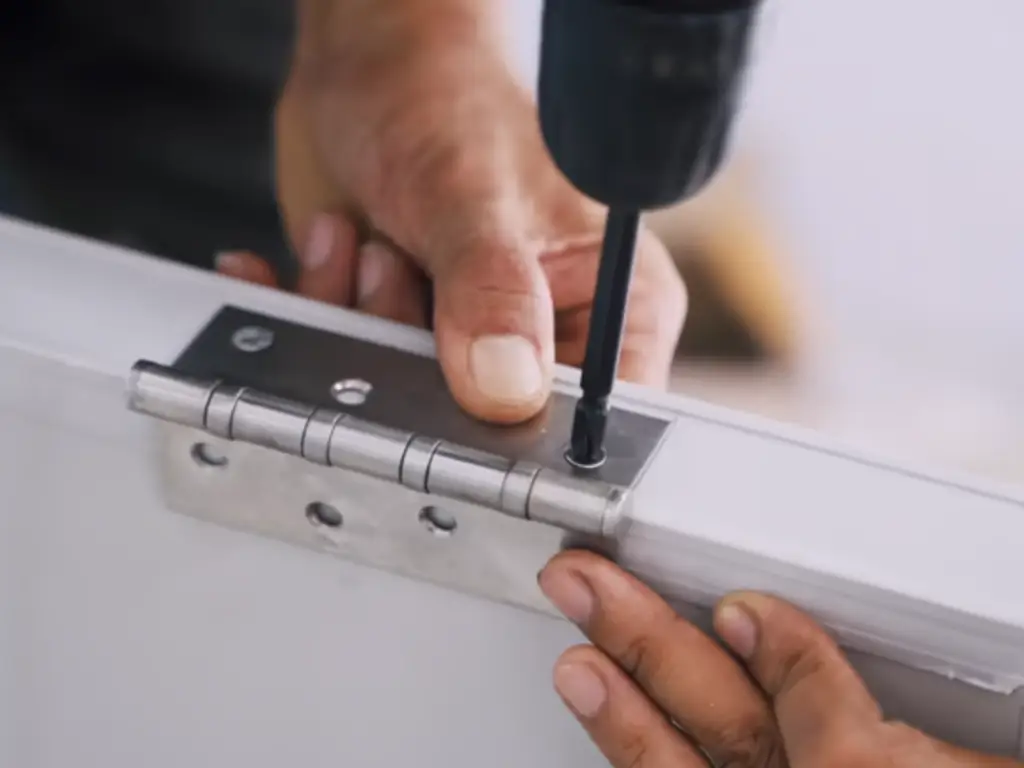
Why Choose KUNLONG for Butt Hinges Needs
In today’s hardware market, choosing a supplier means choosing a partner. With nearly two decades of dedicated focus on industrial hardware since our founding in 2005, KUNLONG is a partner defined by proven expertise and uncompromising quality.
We are quality driven and quality is part of our process. Our starting point is certified materials that are SGS and RoHS compliant, and are globally compliant. We have an unbelievable precision tolerance of 0.0005mm in our manufacturing process and each batch has to go through 15 stringent checks before it is accepted.
This painstaking procedure leads to hinges that have superior performance that is guaranteed. Our products are designed to meet heavy load bearing industrial requirements and have been tested to exceed 1,000 hours to withstand over 1,000 hours in salt spray testing for exceptional corrosion resistance. This is supported by a 20,000+ cycle-life warranty, which means that all products will be able to endure their rated load and environmental conditions in the long-term.
Moreover, we provide end-to-end solutions, which are specialized and take projects from the initial design to the final manufacturing. KUNLONG offers more than a component, with a full one year warranty, KUNLONG offers a complete guarantee of precision, durability and 100% quality assurance to your most critical applications.
Installation and Maintenance Best Practices
Proper installation is the foundation of a hinge’s performance and longevity. Follow these key steps for a professional and secure fit.
| Category | Action | Details |
| Installation | Precision Mortising | Ensure mortises are cut to the exact depth of the hinge leaf, allowing the hinge to sit flush for smooth operation. |
| Use Correct Fasteners | Always use screws supplied by the manufacturer, as they are rated for the hinge’s designated load capacity. | |
| Drill Pilot Holes | Drill properly-sized pilot holes to prevent wood splitting and ensure screws are driven in straight for maximum holding power. | |
| Maintenance | Regular Cleaning | Periodically wipe down hinge knuckles to remove dust, grime, and debris, preventing abrasive wear. |
| Proper Lubrication (When Needed) | Apply a drop of lightweight machine oil or silicone-based lubricant to the joints to prevent squeaking and friction buildup. Avoid heavy greases. | |
| Check Screw Tightness | Regularly check that all hinge screws remain tight, especially on high-frequency doors, to prevent door sag due to vibrations. |
Conclusion
The butt hinge, in all its forms, is a classic of classic design. It is an element that requires a lot of thought because the integrity of a whole assembly is based on its seemingly simple purpose. Learning its anatomy, knowing the unique role of each type, and adhering to a systematic selection procedure, you will be able to make sure that this basic hardware component will do its job perfectly. Whether it is the most silent house or the most challenging industrial facility, the correct hinge is not merely a metal object; it is the silent guarantee of smooth movement and long-term safety.
Want to talk about the specs of your next project? To get a technical consultation, request a CAD file, or a custom quote, contact the KUNLONG engineering team.

